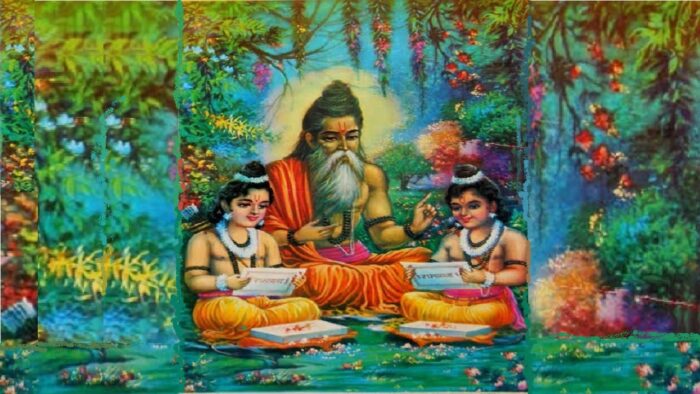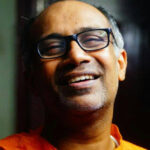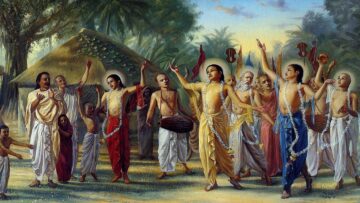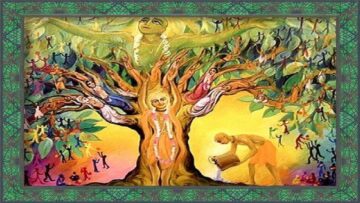Introduction:
He was sworn to silence, so he went into the forest to worship Goddess Vindhyavasini. There he found a group of pishachas having a conversation. He heard them and learnt the Paisachi language, different from all the languages that he had forsaken. Thereafter, “in seven sections of seven lakh shlokas, Gunadhya wrote the story he had heard from Kanabhuti in Paisachi. Afraid that the vidyadharas would steal the story, he wrote it in the deep forest, where no one could see him. And, because he had no ink, the wise Gunadhya used his blood” (Nayak 61). A story written in blood can be assumed to be a story existing in the blood. Paishachi, the language used by Gunadhya to express his story is also lost. Paishachi, figuratively considered to be the language of the ghosts is mentioned in ancient texts such as the Mahabharata and Panini’s Ashtadhyayi (Nayak xvii). So, a mystery builds up around the language and the source of Gunadhya’s story, Brihatkatha. The story that was received by Gunadhya and remained in his body, bereft of all known languages, flowed out in letters of blood. And later, when he was telling the story on a mountaintop, his dreadlocks swung around his face like flames around a burning countenance. And all those who heard him tell the story transformed in their bodies. Kanabhuti regained his form of yaksha, the pishachas went to heaven and Gunadhya himself gave up his human body to regain his vidyadhara form. Bodies melted and bodies transformed while the story got told and retold and retold. Raja Satavahana received and brought the story of Brihatkatha to his Kingdom. And soon he encouraged the translation and retelling of the story in known dialects so that it could be narrated to everyone. Later, the Kashmiri poet Somadeva adapted and retold it in Sanskrit to gift us the phenomenal collection of Indian stories, Kathasaritsagara. It is also mentioned that this was originally told by Shiva to Parvati, heard secretly by a gana named Pushpadanta and later to the yaksha Kanabhuti who was cursed to turn into a pishacha.
Best of the stories are told and retold. The Ramayana that was told to Valmiki by Narada[1] was told to Luv and Kush which were in turn told to Rama and his courtiers. The Mahabharata told by Vyasa was retold by Vaishampayana was heard by the great Puranakathaka, Souti who told it to the Munis attending the Yajna in the forest of Naimisha. These stories are the revelations of the truth embedded in the diverse events that took place on heaven and earth told again and again through time. The truth is ever simple and short so the stories contain only a few immutable details, making them easy to be carried from one telling to the next. The changes introduced by individual tellers during their retelling did not drop the essential element of the stories while they surfed through their world of free imagination and created new experiences for the listeners. Now the questions that emerge out of this brief discussion are: Where was the truth stored? How was it passed? How did the storyteller or his/her body-mind respond to this tradition of ever changing narratives? How can we adapt the same for contemporary storytelling art?
In Katha ‘Koli storytelling practice, we are trying to locate the answers to these haunting questions by exploring our traditional storytelling art and simultaneously, we are trying to introduce new methods of performance art practice to enrich the craft and revive the traditional art in contemporary spaces. In the following paper, I shall share the findings made by us and point out certain interventions proposed by us. Katha ‘Koli is still in its rudimentary state progressing towards a full-fledged art practice. Therefore, the paper is more a hint than a comprehensive understanding of the art.
Body as a Repository of Knowledge:
Storytelling is a performance involving tremendous narrative energy. In storytelling language becomes action.[2] Since ancient times a flow of narrative energy was required to entertain, to keep historical records and to answer their own wonderings. The rich performative tradition of Indian narratives has a primal origin. The narrative creation in the ancient Indian repertoire is variously found in Itihasa, Purana, Akhyana, Katha, Gatha, Sanvada etc. They were mostly in ballad forms and were sung and enacted on occasions of religious or social importance by the ancient performers (Varadpande 81). The Veda mentions about the Gatuvid, who were the carriers and performers of gathas. In Kathasaritsagara as well, there is a mention of a storyteller, Nanda, who is narrating his tale by dancing, acting and using mime. Therefore, to retell a story, it was not only important to remember the story but to embody the telling. The performative aspect of the story was equally important as the text of the story. And we find a similar claim differently posited by Sri K. N. Panikkar who states that the storyteller gradually evolved into a theatre actor[3] [because of its performative element]. But today, when we depend more on written texts we lose the essential component of the story performance. The written stories are meant to be read in isolation and silence to create a different magic, which is but alienated from the community experience of storytelling. Most of the modern stories, which were written to be read in silence, if read aloud before the audience often create boredom and embarrassment. So, a story to be told is to be heard or experienced through one’s entire body. One shall receive the story with his/her body and then transfer it to another body. A mere intellectual exercise (reading in silence) will not empower a storyteller and shall not help in passing it as well.
We have to involve all our senses to enjoy, appreciate and thereafter perform it for others. Our sensory organs are the tools that help us receive and present our stories. In Nyaya Sutra, Maharshi Gautama states that the body is the shelter of our senses[4]. The sensorial world flourishes in the expanse of our bodies. According to Shiva Purana, there are three kinds of bodies, “the gross (sthūla), the subtle (sūkṣma) and the causal (kāraṇa). The gross body is responsible for all activities; the subtle body yields the enjoyment of pleasures through the senses. The causal body is for the sake of experiencing the good and bad results of the activities of the Jiva” (1.18). In storytelling we need to understand and make use of all the three bodies in full capacity. The body is telling the story. However, many performers assume that the consciousness (the atman) is the real teller as the story emerges from the inside of the storyteller, which is not true. In Sankhya Yoga it is mentioned, “tasmat tatsangayogat acetanam lingangam chetanavadiv” (Sankhyatatva Koumudi). The jara body associated with the chetan (consciousness) assumes to be conscious. It is the body which remembers and the body which tells.
The World of Codes:
The gross body is the visible body, which is extensively used in all performative art forms. The manifestation of the gross body into an image is a work of art. As theatre director Jerzy Grotowski’s collaborator writes, “Grotowski… didn’t want [performers] to be intellects at work… We discussed through our actions… for example, when language must be used in the work, either by Grotowski or among the actors themselves, it is a language of images, not the language of things by their names” (Wangh xxiv).
As a storyteller, the gross body is used to create such images. All our actions are the manifestation of the body.[5] The limbs and the muscles form the major part of our gross body. In our ancient practice the hand and feet gestures have been extensively codified. The codification is the fixing of gestures, poses and movements into a code, which is achieved by transcending the daily movement into an ‘extra-daily’ equivalent as mentioned in Natyashastra. The Angika Abhinaya mentioned as one of the four elements of Abhinaya in Natyashastra, employs the codified language of the body to create dramatic moments calling forth the sentiments or rasa. The hands, the feet and other muscles continuously change tensions and positions, both when a performer is speaking, acting or reacting in a situation. Nandikeshwara mentions, “Everywhere the hand goes, the eyes follow, and where the eyes look, thought follows, and where thought goes, feeling follows, and where feeling goes, one finds rasa” (23). The hand speaks as eloquently as the uttered words and contributes extensively to the telling of the story. Similarly, if we observe the Kathakali foot positions and the constant movement of their toes, we will experience a different world of emotions and feelings shared by the performer. The position of the feet also shows the alteration of balance, the opposition of direction and shifting of weights according to the situation performed by the dancer.
The storyteller equally uses his/her limbs to enrich the narrated story. As M. L. Varadpande mentions that folk storytellers like Panadavani performers ‘make the narrative more dramatic’ by gestures ‘not much developed of course, …to delineate the meaning of the text” (89). Kuttu, a narrative form later evolves into a full-fledged drama named Kutiyattam. A Kuttu performer enacts the role of the character he talks about using all the four elements of Abhinaya. In classical Sanskrit monologue performances like Bhana, which adopts the narrative style of storytelling uses the Angika Abhinaya. The Vita is the single character of Bhana who narrates either his own experiences, “consisting of a number of wild activities, or describes particularly the varied activities of others” (Bhat 229). The mode of this narration is akasabhasita. G. K. Bhat mentions that the Vita does not merely narrate but also he acts out the narration supported by appropriate physical gestures, movements and actions (angavikara and abhinaya).
The codified gestures are easy repositories of the emotions and dramatic moments that constituted the stories and thus the body plays a very important role in ancient narrative practices. Body is our memory.[6] The body reflexes remain embedded in our muscles from the time we had roamed forests and stayed in caves. So recreating moments by using muscle memory is a proven practice. In contemporary performance studies as well body plays a dynamic role.
Diana Taylor writes, “Since the 1960s, artists have used their bodies to challenge regimes of power and social norms, placing the body front and center in artistic practice—no longer the object depicted in paintings, or sculpture, or film, or photography but the living flesh and breath of the act itself. For some, performance refers to performance art or body art or live art or action art, terms that accentuate both the centrality of the living artist in the act of doing and the aesthetic dimension, “art” (1) The modern storyteller in contemporary space needs to use the body extensively nurturing the traditional practice with the coexisting understanding of body and its images. The body therefore occupies a privileged space in story performances. The modern body of the storyteller has been empowered and invaded by technology and other innumerable experiences. Use of trans-media storytelling layers the presence and awareness of the storyteller’s body in a more significant and mandatory way. The projection acts as transposed memory along with the memory of the muscles and thus helps in transporting the story from one space-time to another. The projection of bodies were also used by ancient folk storytellers like Patachitra, Kaavad and Chitrakathi artists who painted alternative bodies on various materials to empower the telling. However, along with the gross body the subtle body also plays a significant role in being the carriers of stories from one teller to the other.
The Ancient Art of Seeing and Listening:
The subtle body includes our sensory organs which are vital in receiving and then presenting the stories. All five sensory organs are equally important and their response to a story performance is significant and noteworthy. However, we shall dwell with the two vital organs involved in storytelling that is the eyes and the ears. Eugenio Barba writes, “The eyes are the most active of all human sense organs…. The eyes are continuously moving as they scan and inspect the details of the visual world” (122). Most of our learning and recognition happens through our visual organ; it also stores and reproduces memories in a fascinating way. The memory system of the brain contains a process of recognising and reconstructing of memories. The visual organ plays a vital role in doing so and therefore, when we are sad due to the remembrance of a sorrowful event, it is first projected in our eyes. A storyteller uses his/her eyes with expertise like a classical Indian dancer [may be not that pronounced] to tell the story effectively. Alexander Gladkov says that he can always distinguish a genuine from a poor performer by his/her eyes. The Natyashastra mentions the various eye movements according to the rasas. There are eight kinds of looks, nine movements of eyelids, seven eyebrows. Along with the eyes the facial muscles, nose, chin and neck also move in sync to create the required mood. The traditional Kathakars sitting at one place creates the magic of enticing stories by their Vachika Abhinaya and their facial expressions. Some practitioner feels that the looking does not happen only through the eyes but it engages the entire body. Zeami, the Japanese performer is suggesting that the eyes can see everything except themselves so a performer needs another pair of eyes, which is the heart. This intuitive seeing is metaphorically represented by the heart. A storyteller must have eyes all around.
The second and the other vital sensorial response that is as primordial as learning itself is the art of listening. Stories are built around majorly on telling and listening. However, listening has always been undermined by many storytellers due to its apparent passiveness. If we dig into our traditional practices, we will encounter the vital world of continuous flow of sound sense. The Vedic culture is based on chanting and listening. Listening to an idiolect, nibhasha of mother tongue, is the only way to understand a language and definitely a story (Dharmapal 7). It is said that as a child we learn our first language through the process of whole-hearted listening. Gouri Dharmapal also states that no two individuals can produce same sound exactly alike and no individual can produce same sound exactly alike more than once. So, listening is not meant to copy what one hears but to create a response of that hearing. Therefore, a story can be touched only by diving in the whole flow of the sound-sense-idiom that emerges out of the storyteller’s heart, which one cannot understand by just reading it.
Though, the Natyashastra mentions about the seven notes and their combinations for various sentiments, the anahata or the unheard sound plays a vital role in absorbing the right spirit of the story. And the impossibilities mentioned above in both the visual and auditory discipline of the subtle body can only be accomplished by tuning the causal body or the karana sharira to a pure state.
‘Storytelling as a Spiritual Discipline:
A storyteller is continuously evolving. S/he is capable of risking all of herself/himself by dissolving in the story, and to die each moment the story is over[7]. Storytellers fall in love with their stories and feel an incredible high narrating it, feeling the story passing through one’s entire being. That is why Gunadhya transforms into Vidyadhara after sharing Brihatkatha with the King. It is mentioned so in Kathasaritsagara, “When Parvati’s irresistible allure churned like Mount Mandara in the ocean of Siva’s mouth, the story that emerged was Amrita; whoever respects this elixir and eagerly imbibes it will achieve unimpeded knowledge and high status with Shiva’s grace” (Nayak xv). This altered state of consciousness during telling of a story can be the very essence of being a storyteller. Storytelling is an act of love and a process of transcendence, which provides a deep access to the inner self. As a storyteller a certain aspect of the performance is rehearsed, memorised or is at the conscious level, but there is a whole other level which happens without one’s effort, a primal energy carried over from time immemorial. This energy is felt through the voice, body and the breath. The telling is like waves emanating from our bodies radiating the “flow of linguistic atoms” (svara) towards eternity. This purifies the causal body and provides an experience, which one might call spiritual.
Conclusion:
In Katha ‘Koli storytelling art we believe that all stories are meant to be performed and lived through utterances and expressions to preserve and propagate them. It is a process, which is both, the means (sadhana) and also the goal (sadhya). So the objective is to embody the story and allow the teller to penetrate the inner world of the story and then express it from within. The physical expression of an inner experience is termed as anubhava by Bharata in the Natyashastra. Stanislavski says that ‘It is with our bodies that we transmit our inner experiences to others.’ So, along with our voice training we greatly involve in training our bodies as story listeners and tellers.
It is a ritual process based on evolved Rasa theory of Natyashastra as found in Rupa Gosvamin’s Raganuga Bhakti Sadhana.[8] In Raganuga Bhakti Sadhana, Rupa states that the inner perfected emotions of the characters from the story of the Bhagavatam were physically expressed as anubhavas and the only door of access to the inner emotions of these characters is through these physical expressions or anubhavas. Hence, Rupa suggests that if the seeker or devotee could “somehow take on or imitate the anubhavas of one of the exemplary character,” one could obtain the emotions of that character and come to inhabit the world in which the character resides.
Katha ‘Koli storytelling art practice attempts to inhabit the truth of the stories that one explores and thus stumble upon the identity of the self and offer an immersive experience to the listener. The first step is to listen to the story from a genuine teller if possible (shravana), or else imagine the telling by repeated reading (kirtana) and reach the linguistic stillness (dhyana). Then attempt to recreate the story with the entire body using selective codified gestures and narration (šāriraka and vācika abhinaya) and (sātvika) bhavas. Finally, through storytelling achieve the perfected body as the Siddha Rupa.
Bibliography:
Bhat, G. K. Natya Manjari Saurabha. Bhandarkar Oriental Research Institute. Poona, 1981
Barba, Eugenio and Savarese. A Dictionary of Theatre Anthropology. Routledge. London & New York, 1991
Dharmapal, Gouri. The Linguistic Atom and the Origin of Language. Ritam. Kolkata, 2010
Hodge, Alison. Actor Training. Routledge. NewYork, 2010.
Nayak, Arora Meena. The Kathasaritsagara of Somadeva. Aleph Book company. New Delhi, 2020
Panikkar, K. A. Karimkutty and The Lone Tusker. Seagull. Calcutta, 1992
Sawyer, Ruth. The Way of the Storyteller. Penguin. New York, 1942
Tarlekar, G. H. The Natyasastra. Motilal Banarasidas Publishers Pvt. Ltd. Delhi, 1975
Taylor, Diana. Performance. Duke University Press. London, 2016
Varadpande, M. L. History of Indian Theatre. Abhinav Publication. New Delhi, 1992.
Wangh, Stephen. An Acrobat of The Heart. A Vintage Original. Toronto 2000
[1] Narada had heard the story from Kakabhusandi who had secretly heard it from Shiva who was telling it to Parvati when she desired to hear the story of an ideal man.
[2] According to the British Philosopher J L Austin, there are certain verbs which are performatives; they are actions themselves. For example, “I do” when used by the groom when asked by the priest during the marriage ceremony in the church.
[3] K N panikkar writes, “The traditional concepts of Indian theatre can really be explained only in terms of the process of evolution of the actor from an official shaman to storyteller to performer and subsequently to character, and from the village bard to the sutradhara” (110).
[4] Keshav Mishra writes in his notes that ‘Indriya Shararira Sanyuktam’, i.e. our senses are deeply related to our bodies (62).
[5] According to Nyaya Shastra, all actions shelter in our bodies. Chestashraya Shariram.
[6] Grotowski states, “The body does not have memory, it is memory” (Hodge 211).
[7] Ruth Sawyer writes, “There is a kind of death to every story when it leaves the speaker” (59)
[8] Raganuga Sadhana is a process wherein the devotee enters the story as a way of Salvation
Feature Image Credit: pinterest.com
IndigenousStorytellingTraditions
Watch video presentation of the above paper here:
Disclaimer: The opinions expressed in this article belong to the author. Indic Today is neither responsible nor liable for the accuracy, completeness, suitability, or validity of any information in the article.










